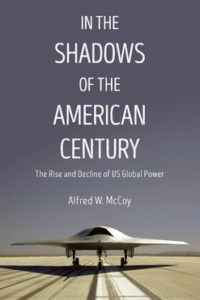
Writing the Untold History of American Imperial Power
Why Was History’s Most Powerful Empire Also Its Least Studied?
Thinking and writing about the United States as an empire has always been full of emotional and ideological pitfalls for historians like myself. During the 40 years of the Cold War, the Soviet bloc used the Marxist-inflected term “imperialist” to denigrate the United States. So this country’s diplomatic historians, operating in a Cold War mode, subscribed to the idea of American exceptionalism. The United States might be a “world leader” or even a “great power,” but never an empire. Our enemy, the Soviet Union, was the one with an empire.
While this belief always struck me as a bit self-satisfied, and maybe even delusional, I kept quiet and stayed within the bounds of this society’s invisible ideological strictures by limiting my writing to the artifacts, the leavings of empire—US colonial rule in the Philippines, CIA covert operations, global drug trafficking, counterinsurgency, torture, and surveillance.
With the end of the Cold War in 1991, the term “empire” suddenly lost its subversive taint. And after decades of thinking about specific aspects of American power, I was finally ready to consider the larger system that encompassed them all, to explore the US global presence. However, I found that the exploration of this country as an empire had been largely conducted not by the academy’s many diplomatic historians but instead by a smaller number of literary scholars who specialized in cultural or postcolonial studies.
Then, in the aftermath of the 2001 terror attacks and the 2003 invasion of Iraq, policy specialists across the political spectrum embraced the concept of empire to ask whether or not US global power was in decline. But there was still little history, particularly comparative history, of the nature of this imperial power. At the peak moment of its global dominion, history’s most powerful empire, now commonly called the planet’s “sole superpower,” was arguably its least studied.
To address this disparity between the enormity of American power and the paucity of its study, some colleagues at the University of Wisconsin-Madison, where a critical perspective had survived the Cold War, launched a project on “Empires in Transition” meant to incorporate America into the comparative history of world empires. Starting in 2004, our small group quickly grew into a network of 140 scholars on four continents who participated in a series of international conferences and published two essay collections bookending the rise and decline of US global power.[1]
To sum up what we found in those 1,200 pages and their hundreds of footnotes, America’s rise to world power over the past 120 years can be envisioned as three distinct phases precipitated by endless wars: first, following the Spanish-American War, a brief yet transformative experience with colonial rule in the Caribbean and the Pacific from 1898 to 1935; next, a sudden ascent to global dominion in the decades after World War II; and, finally, a bid to extend that hegemony deep into the twenty-first century through a fusion of cyberwar, space warfare, trade pacts, and military alliances.
In the century from the Spanish-American War to the end of the Cold War, Washington had developed a distinctive form of global governance that incorporated aspects of antecedent empires, ancient and modern. This unique US imperium was Athenian in its ability to forge coalitions among allies; Roman in its reliance on legions that occupied military bases across most of the known world; and British in its aspiration to merge culture, commerce, and alliances into a comprehensive system that covered the globe.
With that world system came a restless, relentless quest for technological innovation that lent it a distinctive dimension. Not only did Washington strive for military superiority in the three conventional domains of air, land, and sea, but its fusion of science and industry opened new arenas for the exercise of global dominion. The U.S. intelligence community, led by the CIA and the NSA, became a supple, sophisticated instrument for projecting power on a global scale.
At the start of the Cold War, the CIA’s attempt to penetrate communist states failed abysmally in China, Russia, and Vietnam, but the Agency proved far more skilled in manipulating allies on Washington’s side of the Iron Curtain through coups and covert interventions, particularly among the myriad of new nations that emerged in Asia and Africa amid the collapse of the last of the European empires. By the end of the Cold War, clandestine operations had thus become such a critical instrument for power projection that they made up a new, fourth domain of warfare I call the covert netherworld.
During those years as well, Washington also competed in the “space race” with the Soviet Union in ways that, through the world’s first system of global telecommunications satellites, added another novel dimension to its global power. In the decades that followed, Washington would militarize the stratosphere and exosphere through an armada of unmanned drones, making space a fifth domain for great power expansion and future potential conflict.
Finally, thanks to the web of fiber-optic cables woven around the globe for the Internet, the NSA was able to shift its focus from signals intercepts in the sky to probing those cables beneath the sea for surveillance and cyberwar. In this way, cyberspace became the newest domain for military conflict. At the dawn of the 21st century, Washington’s bid for what it termed “full-spectrum dominance” across all six domains of warfare—both conventional (air, land, sea) and clandestine (aerospace, cyberspace, covert netherworld)—gave it a national security state of potentially exceptional strength with which to maintain its global power, despite fading economic influence, for decades to come.
“The American Century” publisher Henry Luce had proclaimed in a Life magazine editorial in February 1941 seemed certain, until quite recently, to reach its full centennial. “As America enters dynamically upon the world scene,” Luce wrote on the eve of World War II, “we need most of all to seek and to bring forth a vision of America as a world power which is authentically American and which can inspire us to live and work and fight with vigor and enthusiasm.”[2] For the next 50 years, the United States had fulfilled those aspirations, ruling over much of the world outside the Iron Curtain with a distinctive mix of cultural attraction and covert manipulation, of supple diplomacy and raw force, of generous aid and grasping profits.
After the Soviet Union imploded in the early 1990s, there seemed no power on the planet that could challenge Washington’s dominion. With the country standing astride the globe like an indomitable titan and no credible challenge on the horizon, Washington’s policy gurus imagined, in the well-publicized words of Francis Fukuyama, that the “end of history” had arrived, making American-style democracy “the final form of human government.”[3] Yet only a decade later, that portentous “end of history” had been swept away and history was back with a vengeance.
With the shock of the 9/11 terror attacks and the subsequent slide into military miasma of Afghanistan and Iraq, there was a growing sense that America’s global power had reached its limits. Yet by the time our scholarly “Empires in Transition” network had finished writing its second collection of essays in 2010, there was still no challenger on the horizon that could turn this downward trend in U.S. power into an actual transition to new rising empire.
Just two years later, however, the National Intelligence Council, Washington’s supreme analytic body, issued a detailed report warning:
By 2030, no country . . . will be a hegemonic power . . . largely reversing the historic rise of the West since 1750. Asia will have surpassed North America and Europe combined in terms of global power, based on GDP, population size, military spending, and technological investment. China alone will probably have the largest economy, surpassing that of the United States a few years before 2030.[4]
If this prediction proves correct, then Washington was starting an imperial transition like those that had spelled the end of earlier empires in centuries past. Suddenly, we could see the shape of a new great power conflict between Washington and Beijing that could determine the course of this still young twenty-first century, prompting me to start work on a new book about this epochal change, In the Shadows of the American Century.
After two decades of extraordinary economic growth, in 2014 China started to reveal its strategy for challenging Washington’s hegemony. Its plans included making massive infrastructure investments that would bind Europe and Asia into a “world island,” the future epicenter of global economic power, while building military bases in the South China Sea that would sever U.S. military encirclement of the sprawling Eurasian landmass.
This Eurasian heartland is so vast, so empty that its development represents a daunting challenge too difficult to grasp by a mere glance at the map. For nearly a thousand years, the sheer scale of these steppes and deserts had served to separate what is in fact a unitary landmass into two continents, Europe and Asia. From the twelfth to the twenty-first century, the endless distances alone challenged any traveler who tried to cross them, rendering Eurasia’s actual geographical unity, in human terms, meaningless. Leaving Venice in about 1270, Marco Polo became one of the first Europeans to travel overland to China, surviving bandits, sandstorms, and wilderness to complete the trek in three years. Some 600 years later in 1907, another Italian aristocrat, Prince Scipione Borghese, won the first Peking (now Beijing) to Paris auto race, driving his 40 horsepower Itala motorcar for 60 days to cover a distance of 9,000 miles and capture the prize fit for a prince—a magnum of Mumm’s champagne.[5]
A century later, the Chinese leadership in Beijing made investment decisions that would change that landscape forever and challenge US dominion. Starting around 2007, China launched the world’s largest burst of infrastructure investment, already a trillion dollars worth and counting, since Washington began building its interstate highway system in the 1950s. Under its disarmingly named “Silk Road Strategy,” the numbers for the rails and pipelines Beijing has been building are mind numbing. The sum of these massive investments represents nothing less than a transcontinental engineering project of sufficient scale to harness the Eurasian heartland as an engine to drive the ascent of a new world power.
Refusing to cede its global dominion, the Pentagon has responded to China’s challenge by shifting some strategic assets to Asia and by launching new “wonder weapons” meant to maintain its “full spectrum dominance” and thereby check any rival power.[6]
Countless unforeseen factors can, of course, subvert these grand strategies. Any number of powerful new forces can suddenly change the trajectory of world history. Projecting present trends into the future is perilously close to a fool’s errand. No methodology can possibly encompass the many moving parts of a world empire, much less the ever-changing interactions among several of these behemoths.[7]
Still, in the early decades of this century, a few key trends already seem clear enough. While the United States enjoyed strong national unity and a bipartisan foreign policy during its first half-century of its global dominion, it now faces the challenge of maintaining stability in a time of deepening social divisions, exacerbated by the slow waning of its world power. In the quarter century since the end of the Cold War, the old bipartisan consensus over foreign policy has given way to entrenched partisan divisions. While Democrats Bill Clinton and Barack Obama tried to maintain Washington’s world leadership through multilateralism and diplomacy, Republicans George W. Bush and Donald Trump have, in a patriotic reaction against a perceived loss of stature, favored unilateral action and military solutions. This conflict whipsaws the country’s foreign policy in contradictory directions, alienating allies and accelerating the decline of its power.
We are undoubtedly at the start of a major transition away from untrammeled U.S. hegemony. If the National Intelligence Council is to be believed, then the American Century, proclaimed with such boundless optimism back in 1941, will be ending well before 2041. After a quarter century as the world’s sole superpower, Washington now faces an adversary with both the means and determination to mount a sustained challenge to its dominion. Even if Beijing falters, thanks to a decline in economic growth or a surge in popular discontent, there are still a dozen rising powers working to build a multipolar world beyond the grasp of any global hegemon.
As the patterns of world power shift in the decades to come, we will learn whether this imperial transition will be similar to any of the epochal events of the past two centuries—whether the global war that defeated Napoleon’s First French Empire in the early nineteenth century, the diplomacy that broke up the Austro-Hungarian and Ottoman empires after World War I, the tempest that crushed the Axis empires during World War II, the quiet entente that marked the imperial handover from London to Washington in the 1950s, or the mass protests that shattered the Soviet empire in the 1990s.
Whether by slow erosion or violent eruption, this ongoing shift in the balance of power bears watching. From everything I have learned over the past 50 years, we can count on one thing: this transition will be transformative, even traumatically so, impacting the lives of almost every American.
*
[1] Alfred W. McCoy and Francisco Scarano, eds., Colonial Crucible: Empire in the Making of a Modern American State (Madison: University of Wisconsin Press, 2009); Alfred W. McCoy, Josep Ma. Fradera, and Stephen Jacobson, eds., Endless Empire: Spain’s Retreat, Europe’s Eclipse, America’s Decline (Madison: University of Wisconsin Press, 2012).
[2] Henry R. Luce, “The American Century,” Life, February 17, 1941, 61, 64.
[3] Francis Fukuyama, “The End of History?” The National Interest 16 (Summer 1989); James Atlas, “What is Fukuyama Saying? And To Whom Is He Saying It?” New York Times Magazine, October 22, 1989, http://www.nytimes.com/1989/10/22/magazine/what-is-fukuyama-saying-and-to-whom-is-he-saying-it.html?pagewanted=all. Accessed March 24, 2016.
[4] Office of the Director of National Intelligence, National Intelligence Council, Global Trends 2030: Alternative Worlds (NIC 2012-001, December 2012), i–iii, 105, http://www.dni.gov/files/documents/GlobalTrends_2030.pdf. Accessed March 24, 2016.
[5] Tracy Powell and Peter Rutimann, “From Peking to Paris,”Automobile Quarterly 47, no. 4 (2007), 101–06.
[6] Adam Tooze, The Wages of Destruction: The Making and Breaking of the Nazi Economy (London: Penguin, 2007), pp. 339, 613, 634.
[7] See, for example, Will and Ariel Durant, The Lessons of History (New York: Simon & Schuster, 1968); Ezra F. Vogel, Japan as Number One: Lessons for America (Cambridge: Harvard University Press, 1979); Jon Woronoff, Japan as (Anything but) Number One (New York: M.E. Sharp, 1990).
__________________________________

Adapted from In the Shadows of the American Century. Used with permission of Haymarket Books. Copyright © 2017 by Alfred W. McCoy.
Feature image: detail from a 1901 cover illustration of Puck by Samuel D. Ehrhart.
Alfred McCoy
Alfred McCoy holds the Harrington Chair in History at the University of Wisconsin-Madison. His 2009 book Policing America’s Empire won the Kahin Prize from the Association for Asian Studies. In 2012, Yale University awarded him the Wilbur Cross Medal for work as “one of the world’s leading historians of Southeast Asia and an expert on . . . international political surveillance.”



















